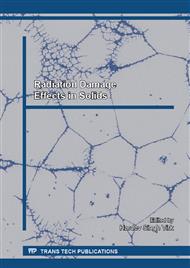p.51
p.69
p.107
p.129
p.143
p.155
p.169
p.181
p.211
Applications of TLDs in Radiation Dosimetry
Abstract:
An increasing amount of public interest in environmental monitoring programmes is being focused on the environmental impact of radiation arising from nuclear power operations and the corresponding detection of slight variations in the natural radiation background. The primary objective of individual monitoring for external radiation is to assess, and thus limit, radiation doses to individual workers. Supplementary objectives are to provide information about the trends of these doses and about the conditions in places of work and to give information in the event of accidental exposure. Depending on the kind of radiation hazard, the ICRP recommended maximum permissible dose (MPD) values. These are the maximum dose equivalent values, which are not expected to cause appreciable body injury to a person during his lifetime. Thermoluminescent Dosimetry (TLD) has been developed during 1960-70 for various applications in medicine and industry. TLD, the most advanced and most intensively studied integrating dosimeter system, has now reached the stage at which it may replace or supplement film dosimetry. TLD systems are widely applied to environmental monitoring programmes near nuclear installations. TLD systems with high reproducibility in the milli roentgen dose range are required in order to measure exposures equal to that resulting from an exposure rate of 10μR h-1 during field periods of from several days up to a year. A brief list of applications specific to radiation oncology is given here. In radiation oncology dosimetric accuracy demanded is of the order of 2-5%. TLDs offer a clear solution since their precision meets this criteria. Contents
Info:
Periodical:
Pages:
211-230
Citation:
Online since:
July 2013
Authors:
Price:
Сopyright:
© 2013 Trans Tech Publications Ltd. All Rights Reserved
Share:
Citation:


